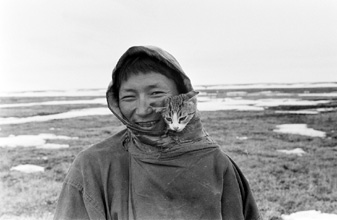Elämän äidit
Mothers of Life
A. Lapsui, Markku Lehmuskallio
Finnland 2002 |
| |
|
 |
|
|
Delphi
11.02., 16.30
CinemaxX 3
12.02., 15.30
Arsenal 1
12.02., 22.00
Babylon
13.02., 13.30
|
|
|
|
|
Produktion: Giron Filmi Oy
Weltvertrieb: Giron Film Oy
Lapinlahdenkatu 29 A 10, 00180 Helsinki
Tel.: (358-9) 6854429
Buch, Schnitt: Anastasia Lapsui, Markku
Lehmuskallio
Kamera: Markku Lehmuskallio
Ton: Antero Honkanen, Anastasia Lapsui
Musik: Usko Meriläinen
Lieder: Anastasia Lapsui
Graphik: Johannes Lehmuskallio
Format: 35 mm, 1:1.85, Farbe und s/w
Länge: 74 Minuten, 24 Bilder/Sek.
Sprachen: russisch, nenet |
|
|
|
| Mothers of Life berichtet vom Schicksal der
Angehörigen von Nubetya Yaptik, die als Nomaden auf der Yamal-Halbinsel
im ös-lichen Sibirien leben. Als wir 1992 und 1993 zum ersten Mal das
alltägliche Leben der Familie von Nubetya Yaptik mit der Kamera begleiteten,
zogen wir fast ein Jahr lang mit ihr gemeinsam durch die Region. Später
erfuhren wir, dass Yaptiks Familie Schwierigkeiten hatte. Wir suchten die
Frauen der Familie in der Tundra auf und baten um Erlaubnis, einen weiteren
Film über sie drehen zu dürfen. Am Anfang erzählt Nubetya,
der Vater der Familie, die Legende von jenem Vorfahren, der sich des Totschlags
schuldig gemacht hatte. Er mußte zur Strafe zusammen mit seiner Familie
in einem geschlossenen Boot zum Salzsee flüchten. Dann kommen wir in
die heutige Zeit und die harte Realität des Alltags. Allmählich
fällt die Familie auseinander und verliert all ihre Besitztümer,
auch die Rentiere. Mothers of Life ist ein Film über eine Mutter und
eine Tochter, Mjusena und Tatjana, zwei starke Frauen, die von Hütte
zu Hütte ziehen, von Familie zu Familie, um einen Platz zu finden,
an dem sie bleiben können. Schließlich findet Tatjana eine Arbeit
in einem staatlich geführten Landwirtschaftsbetrieb. Ihre Mutter Mjusena
schließt sich ihr an. Sie haben ihre Unabhängigkeit verloren
und sind zu Dienstboten geworden. |
| |
|
| Mothers of Life tells about the destinies of Nubetya Yaptik’s
nomadic family on the Yamal Peninsula, in eastern Siberia. In 1992 and 1993,
we shot the film Paradise Lost. In that film we followed the everyday nomadic
life of Nubetya Yaptik’s family. Over the years we received messages
from the Yaptik family, about hardships. We searched for the women of the
family in the tundra and asked for permission to shoot another film about
the family. The women said yes. In Mothers of Life we used both colour material
shot for the film Paradise Lost as well as black-and-white material shot
in 2000 and 2001. In the beginning of the film, Nubetya, the father of the
family, tells the story of a murder committed by an ancestor. The ancestor
had to flee with his family in a closed boat. After drifting for some time
on the sea, they came ashore in the area where their descendants now live.
From the forefather we proceed to the present day, the harsh realities of
today. Little by little, the family falls apart and eventually loses all
their possessions, including all their reindeer. Mothers of Life is a film
about a mother and daughter, Myusena and Tatyana, two strong women who wander
from one hut to another, from people to people, searching for their rightful
place. Finally, Tatyana ends up working at a stateowned farm. Myusena, her
mother, follows her daughter. They are no longer independent, they have
become servants. |
| |
|
Biographien / Biographies
Anastasia Lapsui, Markku Lehmuskallio
Anastasia Lapsui, geb. 1944 in Yar Sale/UdSSR. Zunächst Radio-und Zeitungsjournalistin.
1990 ein erstes Drehbuch. 1993 Beginn der Zusammenarbeit mit Markku Lehmuskallio,
geb. 1938. Zunächst Förster. Dann ab 1974 Filme, im Forum: Das
Opfer - Ein Film über den Wald (1999), Sieben Lieder aus der Tundra
(2000).
|
